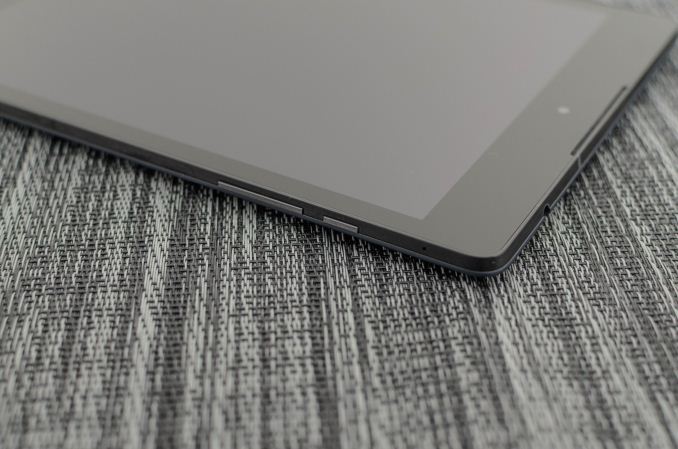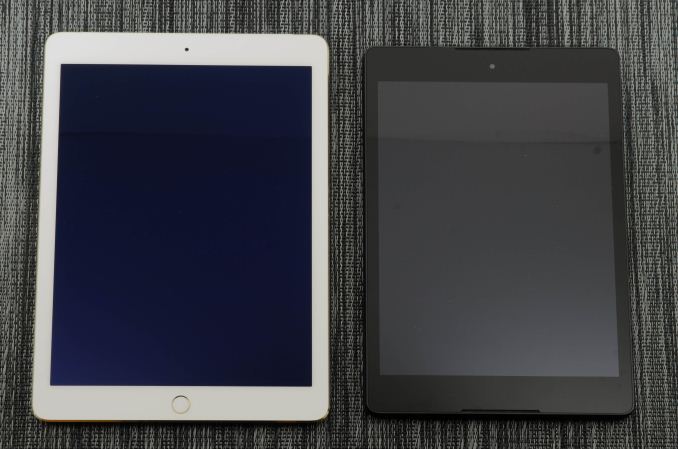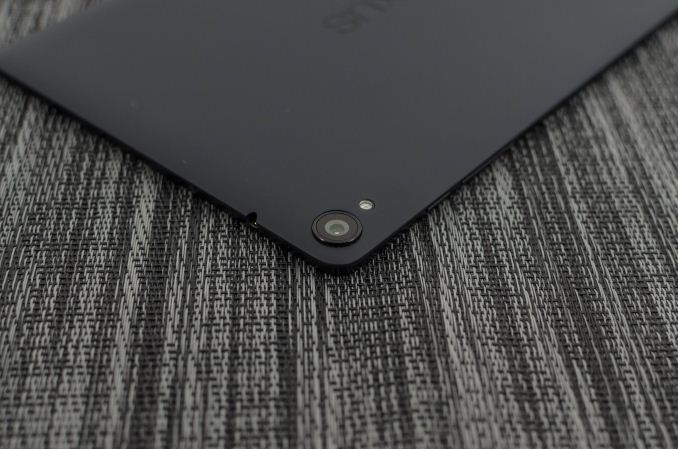The Google Nexus 9 Review
by Joshua Ho & Ryan Smith on February 4, 2015 8:00 AM EST- Posted in
- Tablets
- HTC
- Project Denver
- Android
- Mobile
- NVIDIA
- Nexus 9
- Lollipop
- Android 5.0
Final Words
The Nexus 9 is undoubtedly an aspirational device. For a long time now, Google and the Android tablet market in general have been in a position similar to Amazon’s Fire tablet. This has meant that the margin on the hardware itself has been quite low, and while quality was possible to achieve there were often sacrifices made in order to reach the targeted price point. This was seen in the form of lower CPU and GPU bins in the SoC, lower quality NAND, and generally poorer displays.
The Nexus 7 (2013) did manage to mostly avoid these issues, but Google had set the bar for price and performance to the point where OEMs would have issues with maintaining acceptable profit margins on a device. The Nexus 9 changes this strategy by reaching for a higher price point and attempting to deliver a no-compromise tablet in return. To figure out whether Google has succeeded, it’s worth going over each aspect of the device before coming to any sort of judgment.
The first and quite possibly most important aspect of the Nexus 9 is the SoC. To this end, the Nexus 9 is the very first Android device with AArch64 support enabled in Android. NVIDIA’s Tegra K1 with Denver is effectively the state of the art when it comes to SoCs in the Android OEM space, and no other device has launched with this SoC. While the fact that the SoC is built around the ARMv8 ISA is important, the architecture of the CPU itself is easily one of the most interesting designs we’ve seen in years. Unfortunately, while the design of the CPU is academically interesting it doesn’t seem that this produces real-world benefits. The Nexus 9 has one of the fastest SoCs we’ve seen to date, but this comes at the cost of worse power efficiency than the Cortex A15 version of the Tegra K1.
Another piece of the puzzle is the design, which is one of the key differentiators for a high-end mobile device. While one can debate the merits of various materials, it seems to be clear that an all-metal unibody chassis would’ve greatly improved the design of the Nexus 9 and justified its positioning better. While there is some level of give in the back cover, the buttons are quite thin and hard to find, and there’s a noticeable seam where the back cover and metal frame meet, the design isn’t actually all that bad in practice. Unfortunately, this seems to be a bit of a sore point as well for the Nexus 9 when compared against the iPad lineup.
While the SoC and design are often points of distinction for a premium tablet, the display is critical for any tablet. In this regard, the Nexus 9 does surprisingly well. With a 4:3 aspect ratio, high resolution, and high quality color calibration HTC and Google have outfitted the Nexus 9 with a great display. Unfortunately, there’s a great deal of variability present in these displays that presents itself in the form of backlight bleed along the edges of the display. While my unit only has a slight amount of bleed along the top edge of the device, other units can have more or less backlight bleed depending upon variance in production.
The one aspect that seems to be the product of a poor design choice is the high reflectivity of the display. Although I’m reasonably sure that the display is laminated due to the lack of an obvious gap between the display and glass, it seems that the optical material between the display and glass is poorly designed as I can see a distracting double reflection in the display. The Nexus 9 also compares unfavorably to the iPad Air 2 in this case as the anti-reflective coating on the iPad Air 2 is far superior to just about anything I’ve seen on the market.
Although I previously noted that the power efficiency of the SoC isn’t up to scratch, overall battery life is quite good on the Nexus 9. With a combination of a large battery and efficient display, Google and HTC have managed to compensate for the power consumption issues that come with Denver’s performance. Unfortunately, it seems that Kepler’s desktop-first design results in worse power efficiency than what we see on competing solutions such as the “GXA6850” found in competing SoCs. Even if this is compensated for by the ability to enable desktop-class gaming, the Nexus 9 doesn’t appear to support full OpenGL to begin with, unlike the SHIELD Tablet. This means that the extra capabilities enabled by the GPU are effectively wasted, which hurts the value proposition for the device overall. In light of the launch of the Tegra X1, I can't help but wonder how different the experience of the Nexus 9 would be with NVIDIA's latest SoC.
Outside of these primary elements of the tablet, there seems to be a reasonable level of attention to detail. The camera is acceptable, even if the focus and capture latency aren’t the greatest. The audio quality from the speakers is also quite good, and really helps to enable a great experience when watching any kind of video or listening to music without earbuds/headphones. The software experience is acceptable, although Google continues to fight issues with ecosystem support for tablets.
With all of this in mind, it’s hard to give a resounding recommendation of the Nexus 9. The Nexus 9 is a step towards a high-end Android tablet, but not the leap that Google was hoping for. If you want an Android tablet near the size of the Nexus 9, I can’t really recommend anything else. The Galaxy Tab S falls short on account of performance and battery life, and despite the somewhat unremarkable design of the Nexus 9 I believe that it is nicer than the Galaxy Tab S. However, if one were to assume that OEMs are currently readying devices to truly carry the torch of the high-end tablet, the Nexus 9 is a hard sell. I suspect that this wouldn’t be nearly as difficult if the Nexus 9 had a lower price point of $300 and $350 USD for the 16GB and 32 GB WiFi variants, and $450-$500 for the 32GB LTE variant. Google has managed to get close to the mark with the Nexus 9, but like the Nexus 6 it seems that it’s up to the OEMs to cover the remaining distance.














169 Comments
View All Comments
seanleeforever - Wednesday, February 4, 2015 - link
2nd that.I am not here to read about how fast the tablet is or how nice it looks. i am here for in depth content about the chip. would it be nice that this content was available since the release of the product? absolutely, but given the resource it would either be a brief review that is going to be the same as review you can find from hundred of other websites, or late but in depth.
honestly i think anand should be targeting at more tech oriented contents that's few but in depth, and leave the quick/dirty review for other websites.
superb job.
WaitingForNehalem - Wednesday, February 4, 2015 - link
Yeah but who cares about tablets??!! I don't come to Anandtech to read about budget tablets, or SFF PCs, or more smartphones. The Denver coverage was not even that in depth TBH, just commentary on the NVidia slides. I have a EE degree and some of the previous write ups were so in depth they could be class material. This one isn't which is fine but I don't think it excuses how late it came out. The enthusiast market is growing and you should be targeting that demographic as you previously have, not catering to the mainstream like hundreds of sites already do.retrospooty - Wednesday, February 4, 2015 - link
The enthusiast market is growing ? What with CPU's not really getting, or needing to be any faster for several years now, and a standard mid range quad core i5 (non-overclocked) being WAY more than powerful enough to run 99.9% of anything out there, how is the enthusiast market is growing? Most enthusiasts I know don't even bother any more... There just isnt a need. Any basic PC is great these days.WaitingForNehalem - Wednesday, February 4, 2015 - link
I totally agree with you. That doesn't change the fact that the market is growing as more users are adopting gaming PCs. Enthusiasts now actually command a sizable portion of desktops sold. Intel's Devil's Canyon was in response to that.retrospooty - Thursday, February 5, 2015 - link
OK, I get what you mean.I guess I am still in a mind set where a PC "enthusiast" is your overclocker, tweaker, buying the latest and fastest of everything to eek out that extra few frames per second.
Today, a mid range quad core i5 from 3 years ago and a decent mid-high range card runs any game quite nicely.
FunBunny2 - Thursday, February 5, 2015 - link
There was a time, readers may be too young to have been there, when there was a Wintel monopoly: M$ needed faster chips to run ever more bloated Windoze and Intel needed a cycle-sink to soak up the increase in cycles that evolving chips provided. Now, we're near (or at?) the limits of single-threaded performance, and still haven't found a way to use multi-processor/core chips in individual applications. There just aren't a) many embarrassingly parallel problems and b) algorithms to turn single-threaded problems into parallel code. I mean, the big deal these days is 4K displays? It looks prettier, to some eyes, but doesn't change the functionality of an application (medical and such excepted, possibly).Does anyone really need an i7 to surf the innterTubes for neater porn?
nico_mach - Friday, February 6, 2015 - link
I think the chip coverage was superb, I don't have an EE degree and I'm pretty sure that's what the website is steered towards. And I still think I got it.It's fascinating the number of layers involved in this Android tablet, and speaks to why Apple can optimize so much better. There's the chip->NVIDIA chip optimizer->executable code->Dalvik compiler/runtime->dalvik code. I mean, when the lags are encountered, that's twice as many suspects to investigate.
I still think that the review is a little harsh on Denver. It's hitting the right performance envelope at the right price. While it's an mildly inefficient design, clearly NVIDIA is pricing it accordingly, and that might be a function of moving some of the optimization work to software. And that's work that Apple and MS do all the time - Apple much more successfully, obviously. There's a real gap in knowledge of how efficient Apple's chips are vs how optimized the software/hardware pairing is.
dakishimesan - Wednesday, February 4, 2015 - link
I have no interest in tablets, but the deep dive on Denver was a fascinating read, and still completely relevant even if the product is a few months old. Thanks for the great review.Sindarin - Wednesday, February 4, 2015 - link
...can I offer you a cup of hot chicken soup laddy? .....maybe some vicks vapor rub? lol! c'mon dude! we're all sick(vaca) in December!hahmed330 - Wednesday, February 4, 2015 - link
Hi, outstanding article with incredible attention to detail... Do you think its possible to run Dynamic Code Optimizer on per say 2 or maybe even 4 small cpu cores dedicated to doing all the software OoOE functions instead of using time slicing? (A53s or just some XYZ narrow cores for a potential 2+2 or 4+4 or maybe even 8+8)Also whats the die size of a denver core in comparison to a enhanced cyclone core?? That is where a lot of gains are possible potentially 30%-50%..